Zoonotic Disease Transmission: the Raccoon Dog and COVID 19
The furry animal featured in the photo below, the raccoon dog (Nyctereutes procyonides), made news headlines this week. It has been suggested that perhaps the COVID 19 pandemic began with this critter in a Wuhan, China, live animal market. My blog is not about that corona virus association, although I do intend to look at this animal as a vector of disease in general.
Before last week, I had never heard of a raccoon dog, and yet this species can be found across Asia and in most parts of Europe. According to the European Wilderness Society, the raccoon dog is present in
Baltic States
Scandinavian States
Most of Northern Europe
Eastern Europe
Most of Central Europe
Parts of South Eastern Europe
Areas of Western Europe and
Southern Europe
Recently, individual animals have been spotted in Italy, Turkey and in the UK.
Raccoon Dog

Attribution: Masashi Taomoto. Used under Creative Commons Attribution 3.0 Unported license.
The animal was first identified by John Edward Gray, (1800–1875) in 1834. It is native to East Asia and is considered to be invasive in Europe. As is often the case with an invasive species, the raccoon dog was intentionally introduced to Europe. The animal was highly prized for its fur and was released into Western Russia so it could thrive and be hunted. Thrive it did.
The raccoon dog is a highly adaptive animal. It is omnivorous. Its diet includes, "insects, rodents, amphibians, birds, fish, reptiles, mollusks, carrion, as well as fruits, nuts, and berries." Watch the animal forage in the webcam below (from Finland). The raccoon dog never stops eating.
This animal survives in temperatures that range from -0 degrees C to 30 degrees C. In the winter it grows a thick coat, and even hibernates if the temperature falls low enough. As a matter of fact, the raccoon dog is the only hibernating canid (as far as we know). One reason for this animal's constant eating might be the fact that it fattens up in autumn if it is going to hibernate over the winter.
The raccoon dog is most definitely not a raccoon. Raccoons are in the Procyonidae family and are native to North America. Although the raccoon dog is called a dog and is a member of the Canidae family, it is actually closer to a fox genetically than it is to a dog. Foxes are also in the Canidae family.
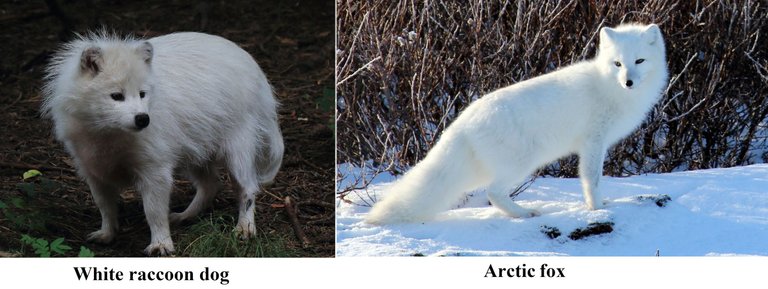
Credits: Arctic fox: Emma on Flikr. Used under Creative Commons Attribution 2.0 Generic license. Raccoon dog: NobbiP. Used under Creative Commons Attribution-Share Alike 3.0 Unported license.
Among the connections between the raccoon dog and the arctic fox is the recently discovered virus, C. amdoparvovirus 3. In 2014 the journal Emerging Diseases reported that a novel Amdoparvovirus, called raccoon dog and fox amdoparvovirus (RFAV), was detected in both animals at a fur farm in China.
While the raccoon dog may compete with native small carnivores such as badgers and the red fox for food in Europe, recent studies show that the competition is "not severe".
In Finland, the raccoon dog is "...the most common mammalian predator" and is responsible for endangering native water fowl. In a test to determine which animal was destroying mallard nests, artificial nests were created. It turned out that the raccoon dog consumed more than half the eggs in the nests.
A test of nest predation in Denmark revealed that foxes destroyed most nests, but the raccoon dog came in a close second.
Mallard Duck Nesting
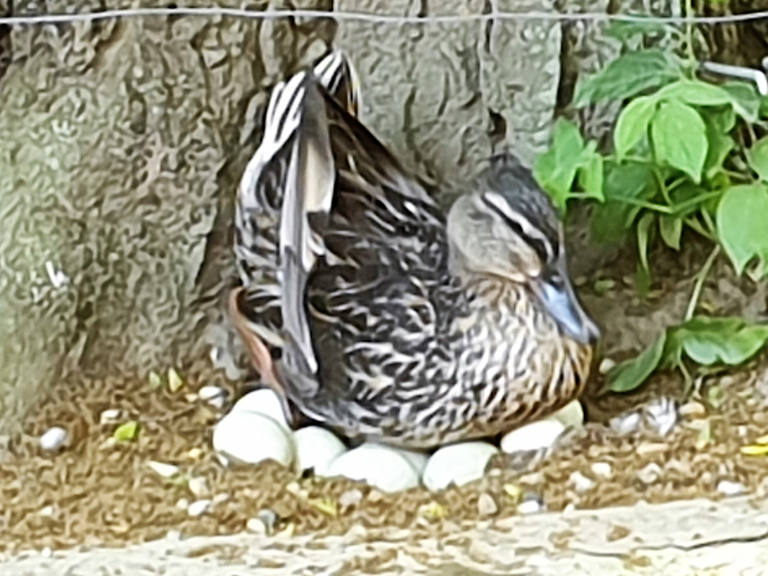
Credit: This file was created by Emőke Dénes and uploaded by DenesFeri. Used under Creative Commons Attribution-Share Alike 4.0 International license.
In many places in the world, the raccoon dog is considered such a threat to native species that trade in the animal is forbidden. It is illegal to import or own own a raccoon dog in the United States. If you want to see this animal in the U. S. you have to visit the Oklahoma Zoo. There used to be a pair of raccoon dogs in the Atlanta Zoo, but apparently the animals died.
Amphibians seem to suffer great loss from raccoon dog predation. In Finland the animal is responsible for extinction of local frog populations. In Sweden the raccoon dog is considered an 'ecological disaster'.
Hunting parties go out to kill these animals because of the threat they pose to ground nesting birds and amphibians, especially. The hunters use so-called "Judas" animals that are sterilized and returned to the wild with transmitters. Since raccoon dogs mate for life, the expectation is that the tagged animal will lead hunters to another, and a mating pair will be eliminated.
Raccoon Dog in Sweden ("Judas Dog") With Transmitters
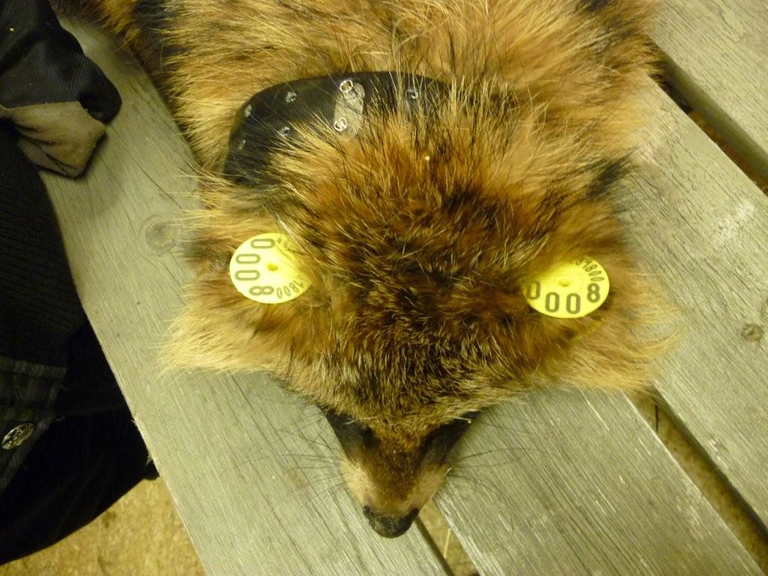
Credit:Svenska Jägareförbundet. Used under CC. 3.0 Unported license.
Although as an invasive species the raccoon dog preys upon native animals and competes for resources with other predatory mammals, these activities do not represent the greatest danger. The greatest danger comes from the pathogens and parasites that are carried by the animal.
In Europe, the raccoon dog is a significant vector for rabies. According to a report issued by the European Commission's Life program, "The raccoon dog is also the single most important vector of rabies in Europe". The report also implicates the animal in transmission of fox tapeworm, sarcoptic mange and trichinellosis.
Trichinella Larvae Embedded in Muscle Tissue

Credit: U. S. CDC. Public domain
Raccoon dogs captured and tested in Austria were not found to have trichinellosis, but did test positive for other pathogens: Echinococcus multilocularis, Alaria alata and Babesia cf. microti. The animals tested in Denmark were positive for five tick born diseases. In addition to the pathogens detected elsewhere, it was determined that 42.7% tested positive for T. gondii (Toxoplasmosis).
I began this article by mentioning that the raccoon dog has been in the news lately. It seems that not only did the tests at Wuhan show DNA of the animal and COVID 19 virus in the same cart, but these were abundantly mixed together. According to Physicians Weekly
Large amounts of the genetic material were a match for the raccoon dog. Material from the raccoon dog and the virus were in the same places.
While this proves nothing, because much data is missing, it is interesting that the raccoon dog was a known carrier of corona virus. In August of 2020, News Medical Life Sciences published a report that said:
Researchers at the Friedrich Loeffler Institute in Germany have conducted a study demonstrating that raccoon dogs were a potential intermediate host in the transmission of severe acute respiratory syndrome coronavirus 2 (SARS-CoV-2) – the agent that causes coronavirus disease 2019 (COVID-19).
Prior to 2020, News Medical Life Science reports, "Natural SARS-CoV-1 infection of raccoon dogs has been documented". The article goes on to draw a relationship between the raccoon dog and the 2002-2003 corona virus outbreak.
Raccoon Dog in a Cage at Live Animal Market in Wuhan
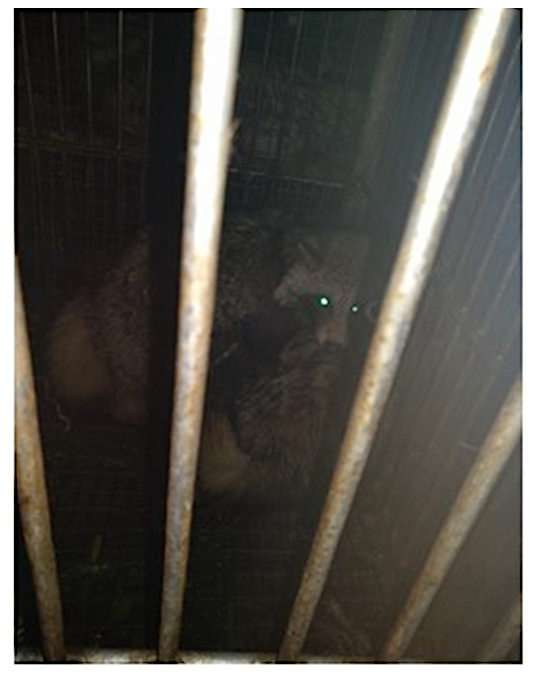
Xiao Xiao, Chris Newman, Christina D. Buesching, David W. Macdonald & Zhao-Min Zhou. Used under Creative Commons Attribution 4.0 International. This picture was taken sometime between May 2017–Nov 2019. This was extracted from a larger, even more upsetting image. I couldn't do that to my readers. This was taken at the Huanan Seafood Market in Wuhan.
Wet Markets (Live Animal Markets) and the Fur Trade as Disease Source
It has been suggested that the live animal market might have led to the COVID-19 outbreak. Additionally, the fur trade has been linked to the incubation and dissemination of pathogens. The caging, close association, and stress of animals under harsh, unsanitary conditions is the pathogenic link between these two environments.
MSPC-Angell, an animal welfare organization in the U. S., describes the circumstance on fur farms, in wet markets, and in factory farms that leads to the zoonotic transmission of disease. (The U.S. CDC reports that "more than 6 out of every 10 known infectious diseases in people can be spread from animals, and 3 out of every 4 new or emerging infectious diseases in people come from animals".)
The following excerpt is from MSPC-Angell
Live animals are kept in cramped and inhumane conditions... Cages are often stacked on top of each other...facilitating easy exchange of bodily fluids. (There are) high levels of stress... illnesses among the animals spread readily. (Live, onsite slaughter) creates many opportunities for viruses to jump from animals to people
After a pathogen has passed from animals to humans, it can 'spillback'. That is, the pathogen can be passed again from human to animal. As this back and forth transmission occurs, the pathogen has the opportunity to evolve, become more transmissible and more deadly.
On fur trade farms, it's not just raccoon dogs that spread disease. It's also mink and fox.
Live animal markets can be found all over the world.
Young Mink Being Fed on a Fur Farm
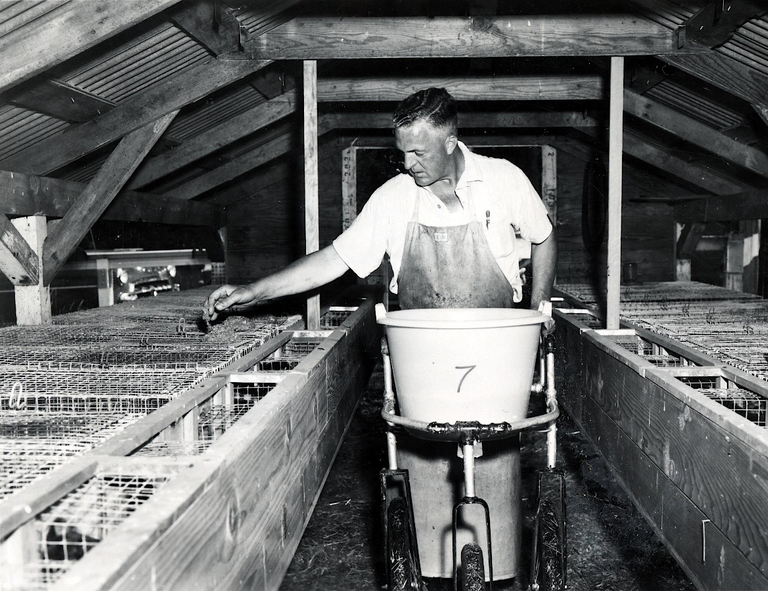
Credit: OSU Special Collections & Archives: Commons. Public domain license.
According to the Humane Society Veterinary Medical Association:
SARS-CoV-2 outbreaks that have been reported on fur farms... in the United States, Canada, Netherlands, Denmark, Italy Spain, and other countries ...this industry is not only cruel and unnecessary but also represents a serious public health risk. ..genetic analysis has shown that workers at mink farms have introduced SARS-CoV-2 to mink and that the animals have spread the virus back to people.
The following countries have banned the fur trade:
Austria, Croatia, Czech Republic, Slovenia, Bosnia and Herzegovina, Luxembourg, Serbia, Italy, France, North Macedonia, the Netherlands, Ireland, Malta and the UK. Israel has banned not just the fur trade, but also the sale of fur.
Finland is the only Scandinavian country that allows raccoon dog fur farms. China is the largest exporter of raccoon dog furs in the world. (source: Canid Specialist Group)
Conclusion
After writing this article I keep thinking, what folly. Whether COVID 19 came from a raccoon dog in Wuhan or not, it is certain that pathogens are exchanged between animals and humans (who are also animals). Money may be important, but is fur? And people eat animals, but do the animals have to be 'harvested' in unsanitary, inhumane conditions? Even if animal welfare is not a concern, should there not be more concern for human welfare as the trade in animals is conducted?


End illustrations:
Bird: @yaziris from the LMAC Gallery of Images
Iguana: @muelli from the LMAC Gallery of Images
Both iguanas and birds are traded illegally.
Research
https://www.physiciansweekly.com/covid-19-origins-tied-to-raccoon-dogs-sold-at-wuhan-market/
https://animaldiversity.org/accounts/Nyctereutes_procyonoides/
https://wilderness-society.org/invasive-alien-species-the-racoon-dog/
https://www.degruyter.com/document/doi/10.1515/mammalia-2022-0076/html?lang=en
https://digitalcommons.usu.edu/cgi/viewcontent.cgi?article=4043&context=wild_facpub
https://www.dailyrecord.co.uk/news/uk-world-news/potentially-dangerous-raccoon-dog-loose-26282247
https://www.biodiversitylibrary.org/part/80278
https://www.allcreaturespod.com/episodes/episode-157-raccoon-dogs-are-real/
https://animalia.bio/raccoon-dog
https://digitalcommons.usu.edu/cgi/viewcontent.cgi?article=4043&context=wild_facpub
https://www.ncbi.nlm.nih.gov/pmc/articles/PMC8125260/
https://www.thecanadianencyclopedia.ca/en/article/raccoon
https://www.ncbi.nlm.nih.gov/pmc/articles/PMC7151911/
https://www.ncbi.nlm.nih.gov/pmc/articles/PMC4257837/
https://www.researchgate.net/publication/282493657_Invasion_of_the_raccoon_dog_Nyctereutes_procyonoides_in_Europe_History_of_colonization_features_behind_its_success_and_threats_to_native_fauna
https://www.earth.com/news/raccoon-dogs-may-be-a-growing-threat-to-waterbirds-in-finland/
https://www.ncbi.nlm.nih.gov/pmc/articles/PMC7097217/
https://www.theatlantic.com/science/archive/2019/06/the-care-and-keeping-of-raccoon-dogs/590800/
https://www.zoochat.com/community/threads/raccoon-dogs-in-the-us.479914/
https://www.bbc.com/news/magazine-36228601
https://webgate.ec.europa.eu/life/publicWebsite/index.cfm?fuseaction=search.dspPage&n_proj_id=3784
https://www.ncbi.nlm.nih.gov/pmc/articles/PMC5360840/
https://www.sciencedirect.com/science/article/pii/S2213224421001012
https://www.news-medical.net/news/20200823/Raccoon-dogs-potential-intermediate-host-for-SARS-CoV-2.aspx
https://en.wikipedia.org/wiki/Huanan_Seafood_Wholesale_Market
https://www.mspca.org/animal_protection/wildlife-markets-coronavirus/
https://www.cdc.gov/onehealth/basics/zoonotic-diseases.html
https://www.ncbi.nlm.nih.gov/pmc/articles/PMC8182890/
https://www.independent.co.uk/climate-change/news/mink-fur-farm-covid-foxes-raccoon-dogs-b1759223.html
https://www.voanews.com/a/science-health_coronavirus-outbreak_live-animal-markets-worldwide-can-spawn-diseases-experts-say/6183154.html
https://www.hsvma.org/fur_riskofdisease
https://www.fourpawsusa.org/campaigns-topics/topics/fur/will-europe-become-fur-free
https://www.canids.org/species/view/PREKLY462191
https://www.canids.org/species/view/PREKLY462191
https://www.ncbi.nlm.nih.gov/pmc/articles/PMC7097217/
https://www.npr.org/2023/03/18/1164527523/raccoon-dogs-coronavirus-wuhan-market
https://onlinelibrary.wiley.com/doi/abs/10.1111/j.1600-0587.1991.tb00662.x
https://www.ncbi.nlm.nih.gov/pmc/articles/PMC5360840/
https://www.sciencedirect.com/science/article/pii/S2213224421001012
https://www.liebertpub.com/doi/abs/10.1089/vbz.2019.2512
https://www.tandfonline.com/doi/full/10.1080/24750263.2022.2070289
https://www.mdpi.com/2077-0383/11/5/1277
https://www.cabidigitallibrary.org/doi/10.1079/cabicompendium.72656#sec-10
https://twitter.com/416626589/status/1638229777105428505
The rewards earned on this comment will go directly to the people( @agmoore ) sharing the post on Twitter as long as they are registered with @poshtoken. Sign up at https://hiveposh.com.
In other news: RACOON DOGS!
They had also blamed pangolins in the early days of the pandemic. It always amazes me to come across creatures that I had no idea existed until recently. The racoon dog and pangolin are two of those creatures, the shoebill is another
There is actually a World Pangolin Day and I follow @luckypango on Twitter: Justice for pangolins everywhere 😁
That is a great picture of a shoebill. Oh my heavens. Look at that beak!
Hi agmoore. I see it more like a raccoon than a dog, but it is a canid. They are beautiful animals, too bad they transmit pathogens like rabies and covid19, I guess you can't breed them like a domestic dog although it would be great. The elaboration of their fur may be the cause of the evolutionary leap of the covid19? Then I think everyone should copy Israel, they ban the purchase and trade of fur.
Hello @innfauno12,
It is a beautiful animal, though my husband does not agree.🙂 They are truly wild, like a fox. Never would make a good pet, from what I read.
I'm not sure why they are such good hosts for pathogens. Maybe it's their diet--they eat everything, including carrion.
Yes, I admire Israel for this step that sets them apart. I am embarrassed for the U.S. where fur farming is a big industry. Thanks for stopping by and reading my blog. It's always a pleasure to hear your opinions.
Take care, @innfauno12
Interesting! I've not come across Raccoon Dogs before.
As to the way we treat animals it's abhorrent, so much so that it has to be kept behind closed doors. I wonder how many people would eat meat if they could see the conditions the animals endure and the manner in which they're slaughtered. But then, I have friends who still eat battery farm eggs despite seeing the state of the ex-battery chickens I've rescued, full of sores and scabs with not a feather on them.
There's nowt so queer as folk!
Hello
Yes, of course you have. I am not surprised. I've seen pictures of your chickens. They are wonderful :)
Amen.
Thanks for reading and commenting, @deirdyweirdy
It is interesting how such a cute animal seem to cause so much trouble not only for the ecology it finds itself in, causing extinction of other animals but then the possibility of it spreading infections to humans, well, it's intriguing to know it had connections to the covid 19 virus, should i say we are the cause of our own problems as a curious species, as humans or ...
Hello,
Life would be easier for this animal if it wasn't so beautiful. People love its fur and that's the pity.
In so many ways, that is true. No thought to consequences. There must be a genetic benefit to that trait in humans, but I don't understand it.
Thanks for reading and commenting. Take care of yourself @nattybongo
Haha we can’t understand ourselves I wonder how we can fathom some of these other species 😂
It was a pleasurable read Sir, thanks for sharing
Thanks for your contribution to the STEMsocial community. Feel free to join us on discord to get to know the rest of us!
Please consider delegating to the @stemsocial account (85% of the curation rewards are returned).
Thanks for including @stemsocial as a beneficiary, which gives you stronger support.
This is the first time I am hearing of raccoon dogs too, we just need to watch out for safety, there are various zoonotic diseases out there that can affect human health.
Thank you for visiting and commenting, @busted1.
Every time I write a blog I learn something new. For me that's one of the best parts of Hive.
You are correct. We must be aware of the danger even cute animals can present :)
The first photo of the raccoon dog looks a lot like the raccoons here, except for the longer legs. It has the mask on the face and the ringed tail. True that animals can carry diseases and the transfer can go back and forth between human and animal. Ticks seem to be rampant in the woods now and easily attach to any wildlife.
It’s scary how cruel and unfeeling how humans can be to animals and I might add to other humans. Thanks for bringing these situations to light.
Thank you very much for visiting, @redheadpei. I learned a lot from writing this post. First of all, this is a new animal to me. Then, I wasn't aware that wet markets were so common all over the world. Also, I was very disappointed in Finland for being rather singular in allowing the fur trade.
As for ticks: We should invite opossum to live in our yards. These critters live on ticks😇. They get along fine with cats and don't carry rabies. Plus I think they are adorable. We usually have at least one roaming around (they like the cat food) but I haven't seen any for a while.
Have a wonderful week my friend.